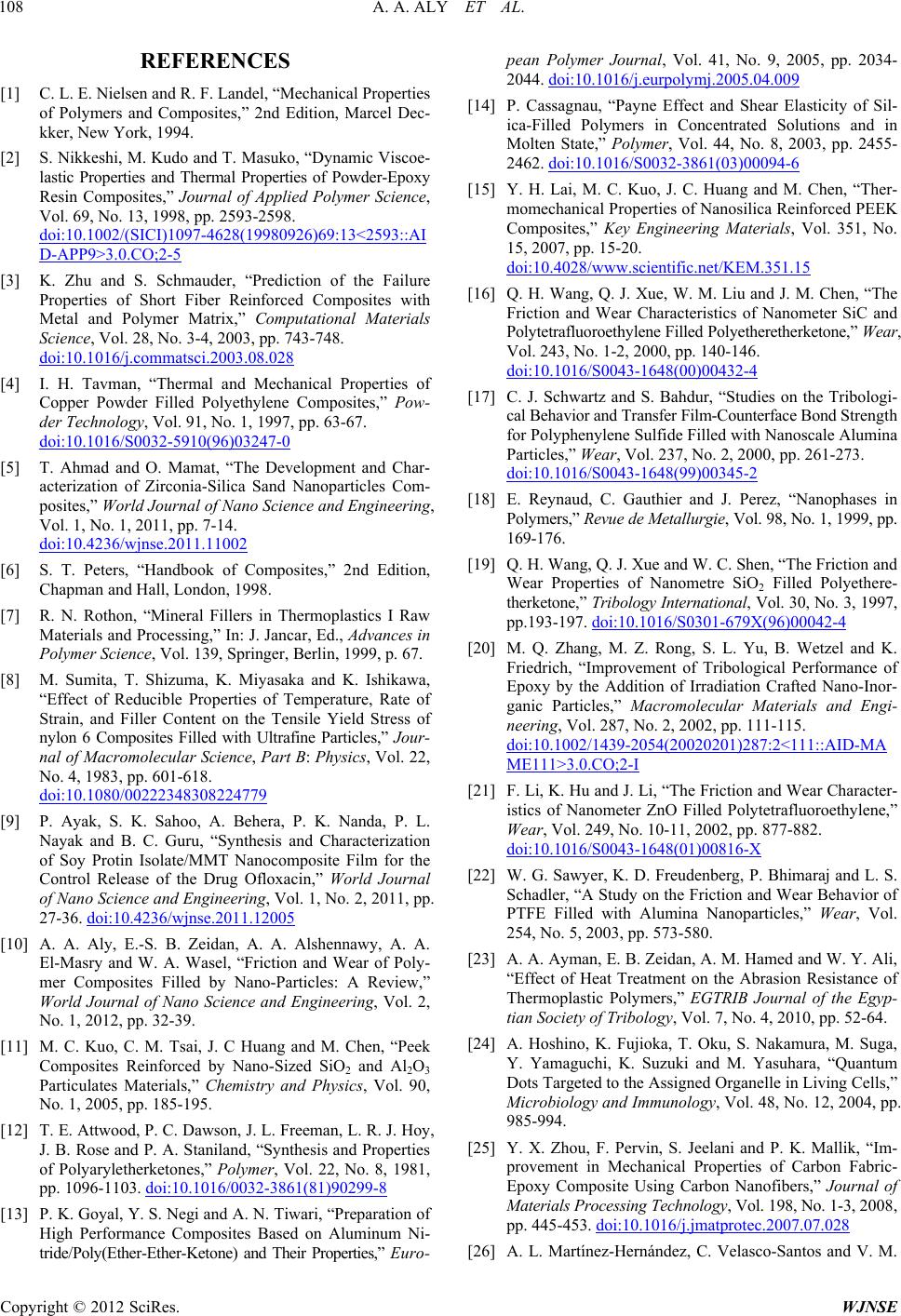
A. A. ALY ET AL.
108
REFERENCES
[1] C. L. E. Nielsen and R. F. Landel, “Mechanical Properties
of Polymers and Composites,” 2nd Edition, Marcel Dec-
kker, New York, 1994.
[2] S. Nikkeshi, M. Kudo and T. Masuko, “Dynamic Viscoe-
lastic Properties and Thermal Properties of Powder-Epoxy
Resin Composites,” Journal of Applied Polymer Science,
Vol. 69, No. 13, 1998, pp. 2593-2598.
doi:10.1002/(SICI)1097-4628(19980926)69:13<2593::AI
D-APP9>3.0.CO;2-5
[3] K. Zhu and S. Schmauder, “Prediction of the Failure
Properties of Short Fiber Reinforced Composites with
Metal and Polymer Matrix,” Computational Materials
Science, Vol. 28, No. 3-4, 2003, pp. 743-748.
doi:10.1016/j.commatsci.2003.08.028
[4] I. H. Tavman, “Thermal and Mechanical Properties of
Copper Powder Filled Polyethylene Composites,” Pow-
der Technology, Vol. 91, No. 1, 1997, pp. 63-67.
doi:10.1016/S0032-5910(96)03247-0
[5] T. Ahmad and O. Mamat, “The Development and Char-
acterization of Zirconia-Silica Sand Nanoparticles Com-
posites,” World Journal of Nano Science and Engineering,
Vol. 1, No. 1, 2011, pp. 7-14.
doi:10.4236/wjnse.2011.11002
[6] S. T. Peters, “Handbook of Composites,” 2nd Edition,
Chapman and Hall, London, 1998.
[7] R. N. Rothon, “Mineral Fillers in Thermoplastics I Raw
Materials and Processing,” In: J. Jancar, Ed., Advances in
Polymer Science, Vol. 139, Springer, Berlin, 1999, p. 67.
[8] M. Sumita, T. Shizuma, K. Miyasaka and K. Ishikawa,
“Effect of Reducible Properties of Temperature, Rate of
Strain, and Filler Content on the Tensile Yield Stress of
nylon 6 Composites Filled with Ultrafine Particles,” Jour-
nal of Macromolecular Science, Part B: Physics, Vol. 22,
No. 4, 1983, pp. 601-618.
doi:10.1080/00222348308224779
[9] P. Ayak, S. K. Sahoo, A. Behera, P. K. Nanda, P. L.
Nayak and B. C. Guru, “Synthesis and Characterization
of Soy Protin Isolate/MMT Nanocomposite Film for the
Control Release of the Drug Ofloxacin,” World Journal
of Nano Science and Engineering, Vol. 1, No. 2, 2011, pp.
27-36. doi:10.4236/wjnse.2011.12005
[10] A. A. Aly, E.-S. B. Zeidan, A. A. Alshennawy, A. A.
El-Masry and W. A. Wasel, “Friction and Wear of Poly-
mer Composites Filled by Nano-Particles: A Review,”
World Journal of Nano Science and Engineering, Vol. 2,
No. 1, 2012, pp. 32-39.
[11] M. C. Kuo, C. M. Tsai, J. C Huang and M. Chen, “Peek
Composites Reinforced by Nano-Sized SiO2 and Al2O3
Particulates Materials,” Chemistry and Physics, Vol. 90,
No. 1, 2005, pp. 185-195.
[12] T. E. Attwood, P. C. Dawson, J. L. Freeman, L. R. J. Hoy,
J. B. Rose and P. A. Staniland, “Synthesis and Properties
of Polyaryletherketones,” Polymer, Vol. 22, No. 8, 1981,
pp. 1096-1103. doi:10.1016/0032-3861(81)90299-8
[13] P. K. Goyal, Y. S. Negi and A. N. Tiwari, “Preparation of
High Performance Composites Based on Aluminum Ni-
tride/Poly(Ether-Ether-Ketone) and Their Properties,” Euro-
pean Polymer Journal, Vol. 41, No. 9, 2005, pp. 2034-
2044. doi:10.1016/j.eurpolymj.2005.04.009
[14] P. Cassagnau, “Payne Effect and Shear Elasticity of Sil-
ica-Filled Polymers in Concentrated Solutions and in
Molten State,” Polymer, Vol. 44, No. 8, 2003, pp. 2455-
2462. doi:10.1016/S0032-3861(03)00094-6
[15] Y. H. Lai, M. C. Kuo, J. C. Huang and M. Chen, “Ther-
momechanical Properties of Nanosilica Reinforced PEEK
Composites,” Key Engineering Materials, Vol. 351, No.
15, 2007, pp. 15-20.
doi:10.4028/www.scientific.net/KEM.351.15
[16] Q. H. Wang, Q. J. Xue, W. M. Liu and J. M. Chen, “The
Friction and Wear Characteristics of Nanometer SiC and
Polytetrafluoroethylene Filled Polyetheretherketone,” Wear,
Vol. 243, No. 1-2, 2000, pp. 140-146.
doi:10.1016/S0043-1648(00)00432-4
[17] C. J. Schwartz and S. Bahdur, “Studies on the Tribologi-
cal Behavior and Transfer Film-Counterface Bond Strength
for Polyphenylene Sulfide Filled with Nanoscale Alumina
Particles,” Wear, Vol. 237, No. 2, 2000, pp. 261-273.
doi:10.1016/S0043-1648(99)00345-2
[18] E. Reynaud, C. Gauthier and J. Perez, “Nanophases in
Polymers,” Revue de Metallurgie, Vol. 98, No. 1, 1999, pp.
169-176.
[19] Q. H. Wang, Q. J. Xue and W. C. Shen, “The Friction and
Wear Properties of Nanometre SiO2 Filled Polyethere-
therketone,” Tribology International, Vol. 30, No. 3, 1997,
pp.193-197. doi:10.1016/S0301-679X(96)00042-4
[20] M. Q. Zhang, M. Z. Rong, S. L. Yu, B. Wetzel and K.
Friedrich, “Improvement of Tribological Performance of
Epoxy by the Addition of Irradiation Crafted Nano-Inor-
ganic Particles,” Macromolecular Materials and Engi-
neering, Vol. 287, No. 2, 2002, pp. 111-115.
doi:10.1002/1439-2054(20020201)287:2<111::AID-MA
ME111>3.0.CO;2-I
[21] F. Li, K. Hu and J. Li, “The Friction and Wear Character-
istics of Nanometer ZnO Filled Polytetrafluoroethylene,”
Wear, Vol. 249, No. 10-11, 2002, pp. 877-882.
doi:10.1016/S0043-1648(01)00816-X
[22] W. G. Sawyer, K. D. Freudenberg, P. Bhimaraj and L. S.
Schadler, “A Study on the Friction and Wear Behavior of
PTFE Filled with Alumina Nanoparticles,” Wear, Vol.
254, No. 5, 2003, pp. 573-580.
[23] A. A. Ayman, E. B. Zeidan, A. M. Hamed and W. Y. Ali,
“Effect of Heat Treatment on the Abrasion Resistance of
Thermoplastic Polymers,” EGTRIB Journal of the Egyp-
tian Society of Tribology, Vol. 7, No. 4, 2010, pp. 52-64.
[24] A. Hoshino, K. Fujioka, T. Oku, S. Nakamura, M. Suga,
Y. Yamaguchi, K. Suzuki and M. Yasuhara, “Quantum
Dots Targeted to the Assigned Organelle in Living Cells,”
Microbiology and Immunology, Vol. 48, No. 12, 2004, pp.
985-994.
[25] Y. X. Zhou, F. Pervin, S. Jeelani and P. K. Mallik, “Im-
provement in Mechanical Properties of Carbon Fabric-
Epoxy Composite Using Carbon Nanofibers,” Journal of
Materials Processing Technology, Vol. 198, No. 1-3, 2008,
pp. 445-453. doi:10.1016/j.jmatprotec.2007.07.028
[26] A. L. Martínez-Hernández, C. Velasco-Santos and V. M.
Copyright © 2012 SciRes. WJNSE